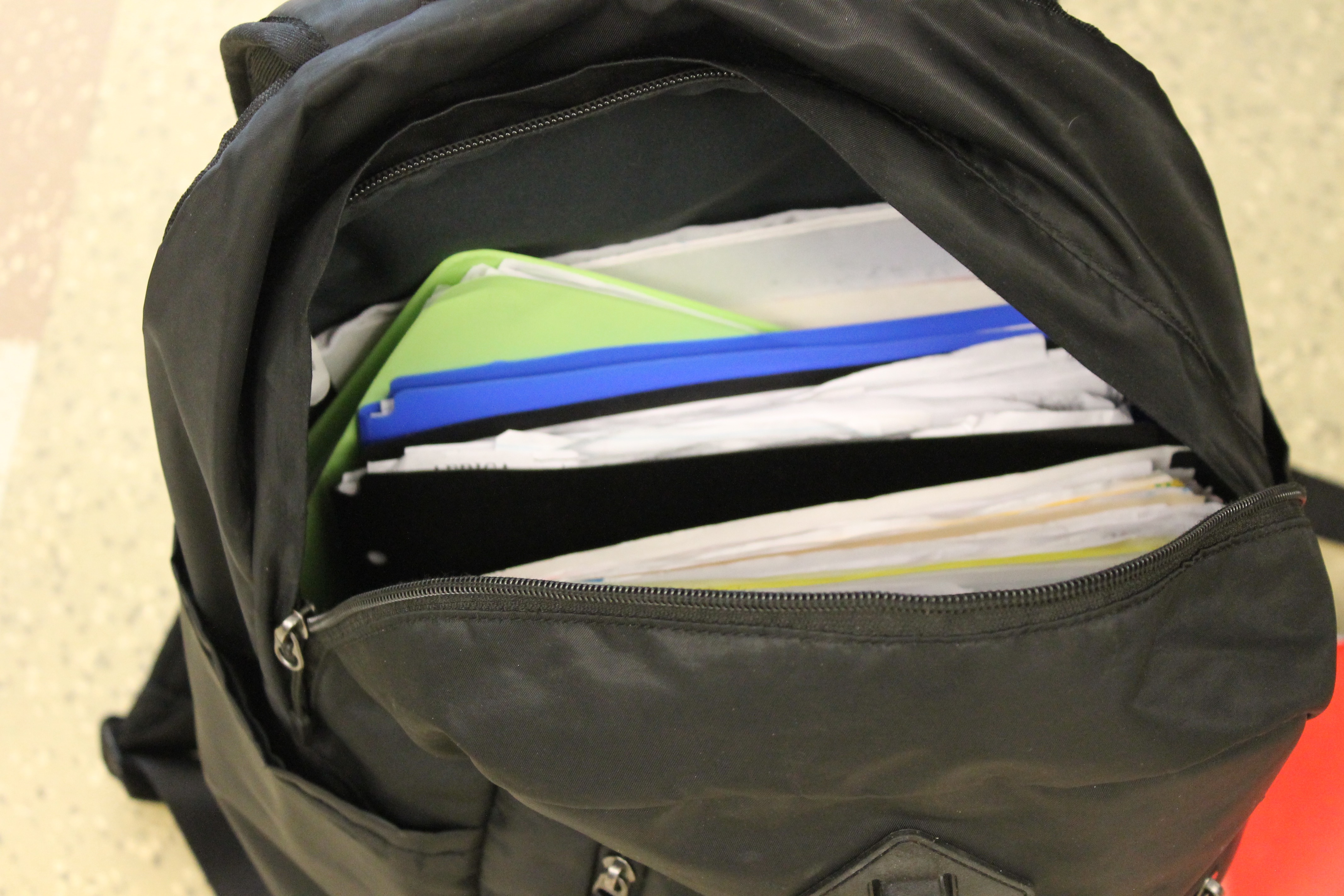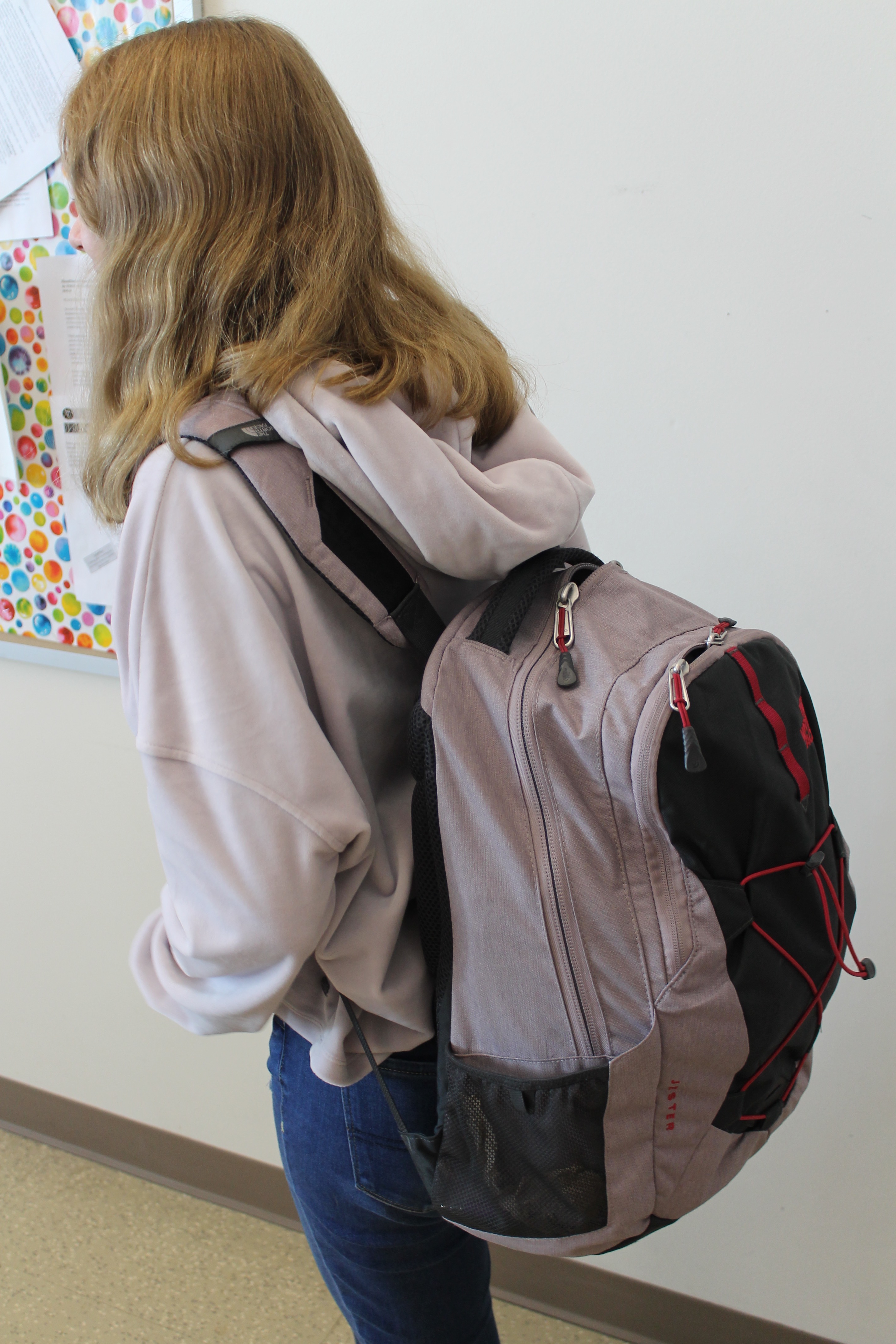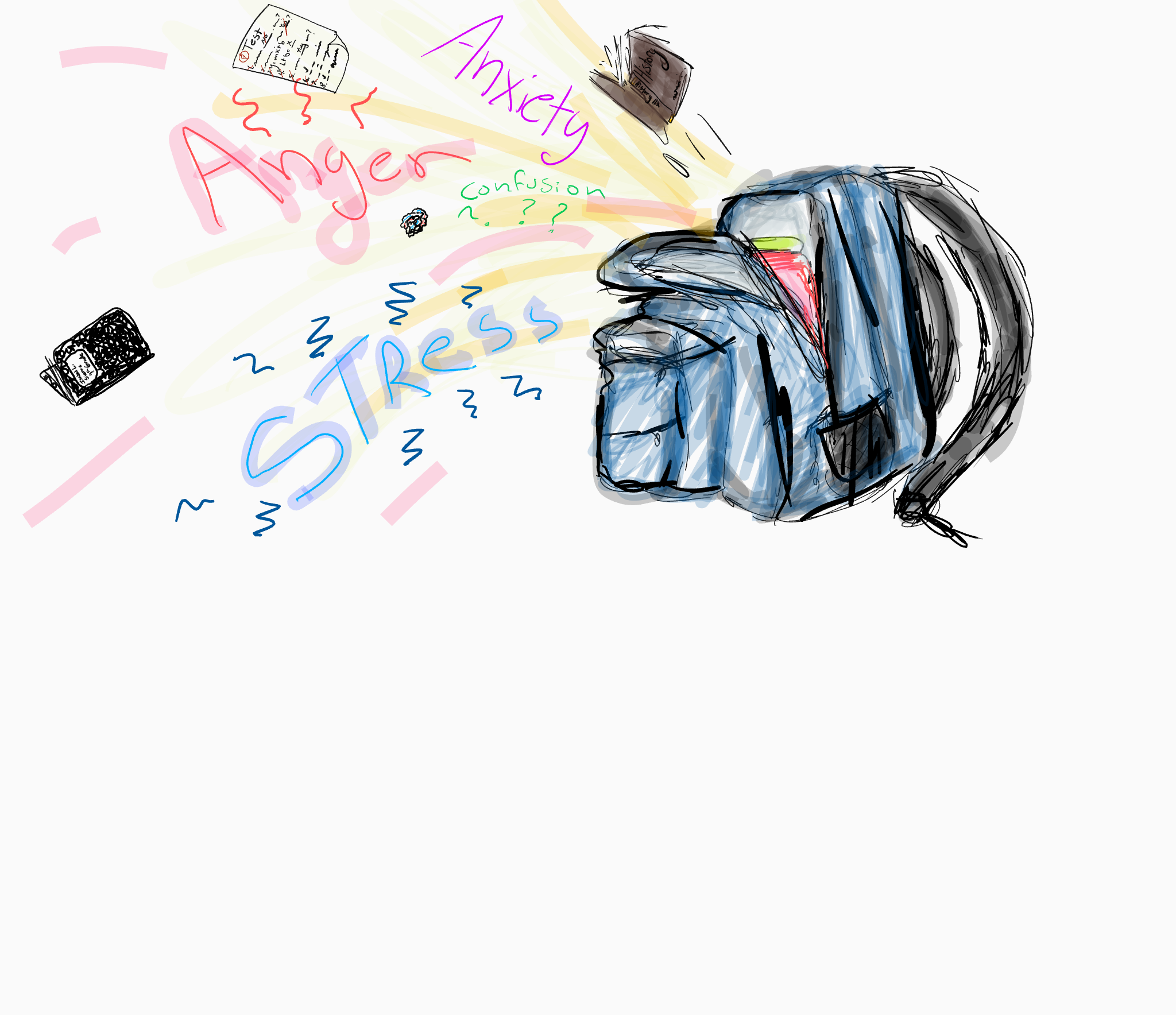The Weight We Carry
There’s things you can see: textbooks, Chromebook, a lot of pencils, some gum, notebooks we never write in, headphones and deodorant because people just need to second-coat that throughout the day.
There’s things you can’t see: the pressure that gets put on us, the fact that we’re actually stressed about grades, messed-up sleep schedules because of jobs, family issues, the fear of failure and the future and never being good enough.
The Physical Toll of Backpack Weight
Let’s start with the things you can see. High schoolers are LITERALLY bending over backwards because their backpacks are like boulders holding them down. We conducted research where we weighed students’ backpacks and the weight ranged from 11.2 lbs to 29.4 lbs. The average backpack weight of the 45 backpacks that The Tribune weighed was 17 lbs. Students are required to carry an enormous amount of things that we DO NOT need. The school just paid for us to have these new fancy chromebooks, yet we are still carrying textbooks, notebooks and papers that get handed out to us. Not to mention sports equipment that does not fit in our lockers.
We asked students why they don’t use their lockers and many of them answered with “there isn’t enough time to stop.” Students are allowed four minutes between bells. We tested the farthest point in the school to the other farthest (the field house to Mr. Ruther’s classroom). It took us about six minutes including stopping at our lockers and using the bathroom (which we are told to do before class).
How much should a backpack generally weigh? The AAP (American Academy of Pediatrics) states that a backpack should not weight more than 20% of your body weight. The American Occupational Therapy Association states that a backpack should weight not more than 10% of a child’s body weight.
The proper way to wear a backpack is with both straps on your shoulders, and with your backpack higher up on your back. The weight should be distributed evenly (www.verywellfit.com).
There are also health problems that come with wearing a backpack that is too heavy. According to KidsHealth.com wearing a backpack that is too heavy, or wearing it the wrong way, can cause bad posture which can lead to back pain.
Lighten your load, and wear your backpack properly to prevent these issues. If you cannot remember your locker number or lock combination ask the office staff.

The Mental/Emotional Toll of Backpack Weight
“It’s like you want to explode, but you can’t.” “You feel like your head is full of so many things at once.” “I found myself wondering, what if the sun exploded right now? I wanted the sun to explode.” “It’s like an asthma attack. You can’t breath.” While it may seem that these people are describing something unimaginable, they’re actually describing something we’ve all experienced to some degree at some point in our life: stress and anxiety. Although it seems to be the norm to most teens today to be constantly under stress and anxiety, this wasn’t always the case.
When conducting two studies on stress and anxiety levels on teens today, the ADAA (Anxiety and Depression Association of America) discovered that the average teen has the same stress and anxiety level as a psychiatric patient in the 1950s, but why exactly is this? Before looking further into this, we at the Talawanda Tribune would like to address the fact that this comparison can be taken offensively, however it is not our intention to offend anyone; we are writing this article only to draw attention to the problem of student stress.
One answer could be the increased requirements to graduate high school. When asked about what has changed since he was a Talawanda student that may have contributed to the rise of stress levels, Mr. York said that he considered high stake testing, or the EOC exams, one of these changes. “You consider points from the ODE and then Talawanda credits and you have a lot to worry about filling both of those complicated requirement,” York said.
On the EOC exams, a student must earn a total of at least four points on the English tests, four points on the Math test, and six points on science and social studies tests; up until this year, if a student failed to meet these requirements, they would’ve not be able to graduate. These exams were introduced to Ohio schools only recently, and they’re just another thing for students to worry about.
Another answer could be the expectations placed on students. In the 1950s the amount of people 25 and older who had a bachelor’s degree or higher sat just below 10%, over 60% less than today. For most people, college is no longer a choice, but rather an expectation.
Georgetown Center of on Education and the Workforce analysis claims by the year 2020, 65% of all jobs in the economy will require postsecondary education and training beyond high school. With that being said, more students than ever before now will have to worry about not only meeting the requirements for graduating high school, but also meeting the requirements for being accepted into a college. Most Colleges actively seek out students who are involved in their school and community leaving many students joining more advanced class and doing extracurriculars that can take up time for activities needed for their mental health, such as sleep.
“I think stress on young people’s’ time and their ability to fit so many different things into a limited number of hours plus sleep, because sleep is so important,” said Amy Macechko, Health and a Wellness Coordinator for the Talawanda School District. “And I think that is an epidemic and a health crisis in itself, that young people are not getting the amount of sleep that they need to be well and functional during the day. I’m very passionate about that. So yes, there is so much, whether it’s academic pressures, to be successful, to be involved in a bunch of different things, to take your sports career, your extracurricular activities, to take all of that to the next level,” Macechko said.
Finally, the increase in student stress might just be related to technology use. A majority of teens today use some form of social media on a daily basis to stay connected with friends and family. While being able to easily stay in touch with people may seem beneficial, it can actually cause more harm than good.
“I think technology adds to the stress because all of a sudden everything is here and now and this second. Compared to 20 years ago, where I think stress came from school and managing a job, activities,” said Theresa Peters, a guidance counselor at Talawanda High School. “But now all of a sudden you all have stress from every second being connected to every person and knowing every single thing that is going on with everyone in your life,” Peters said.
According to Anxiety and Depression Association of America, most people like to show off, so they will only post their best moments online. Although everyone has their own problems, seeing these post can lead to teens thinking that their friends are perfect, while they are less than so.
With all the changes from the past to now, it’s clear to see why students are much more stressed than ever before; the question is, what are schools and adults doing about it?
Teacher Vs. Student Perceptions of School Stress
When interviewing the Talawanda student body, 77.5% (102 student respondents on an anonymous Tribune survey) of students said that school stressed them out the most over after school jobs, home life, or clubs or sports. With such a high percentage, one would hope that the school and teachers are aware of this.
After seeing the overwhelming percentage of students saying that school stressed them out more that home life, jobs, and clubs and sports, we decided to interview teachers to get their perspectives on how stressful their classes are. Surprisingly, their answers seemed to greatly contradict the students answers.
Two of the four teachers interviewed said that that their classes weren’t stressful at all, but the other two said it depends upon the student and what is going on with them outside of school. “Extracurricular activities plus driving tests can make it more stressful for students,” Mrs. Raynold, biology teacher, said. Three out of the four teachers said that they give tests once every two to three weeks. Two teachers said they gave an hour or two of homework a week and the other two said they give no homework and students only have to do assignments that they don’t finish in class for homework.
One thing is for sure, regardless of whether or not teachers believe it, Talawanda High School students are stressed about school and carrying a lot of weight on their shoulders.




